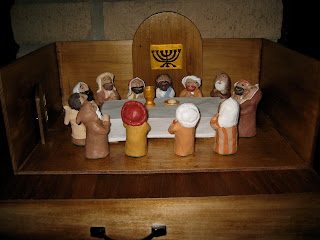To do the City, I bought children's building blocks from Sears. I thought the finish and color was pretty and light. I used a jig saw to cut some of these small blocks in half and then glued them to others with wood glue. I learned that you have to go very very slowly while cutting in half, otherwise the wood goes out of control and can be dangerous. My husband bought me a little Drummel drill with different bits. It's small and fun to use - a real ladies' tool. Dentists use it as well, so you know it is used for tedious small areas. I used the Drummel drill to make groves on top of the castle and walls to look like the parapets in the photographs I found. The Drummel helped to make windows, stairs. and the opening of the tomb also. I Googled the City of Jerusalem and discovered that there are photographs of a miniature city in Jerusalem showing what it looked like in Jesus' time. I was amazed how beautiful, lavish, and white it was with golden trim.
I used foam board which I bought at the dollar store and Staples for the map. I also got the yellow poster paper from Staples to trace the buildings for the map. I then cut out the shapes from the poster paper and glued them on to the foam board. I did the roads and waterways first. I would suggest using a paintbrush and paint to make the roads on the foam board. I used felt tip for the blue waterway and was sorry later because it didn't stand out as brightly as the paint.
Researching photos online of Jerusalem were very helpful to me. I did a lot of research as well about the pools and the ancient staircase leading from the lower city to the upper city. I made a book on this information which has been very useful in my understanding and so I found I could explain things much more interestingly to the children. So I strongly suggest you do a lot of reading when doing this work. That's the joy of this work, you learn as you prepare the materials to teach.

I bought heavy plastic at Walmart to cover the maps to protect them from damage. I taped them tight on the other side. They've held up well over the years without any fingerprints.

I bought heavy plastic at Walmart to cover the maps to protect them from damage. I taped them tight on the other side. They've held up well over the years without any fingerprints.

This is St. Patrick's City of Jerusalem in Tucson. As you can see from the three different versions of the City, there are subtle differences. For example, St. Anne's uses poster board paper as does St. Patrick's for the maps. I used foam board. I like the fact that you can lift it up with some of the pieces intact in case you have to move it around the room. St. Anne's City is smaller than mine and St. Patrick's is larger.
St. Anne's uses two small desks. St. Patrick's uses a larger table for display and I used a table the size of the foam board and made a smaller table to fit underneath for when we weren't using the City.
I bought the squared legs from Lowe's and Home Depot and had them cut to the height I wanted.

(At right St. Anne's City of Jerusalem)
Finally, below I am attaching a closeup so you can see ours at St. Andrews in detail. For the tomb, I glued four blocks together. One was a half circle. With the Drummel, I drilled a hole in the front and made the surface very uneven to create a hilly look. I wanted very little color and only painted the pools, blue; the top of Herod's Palace, gold along with the golden doors; and the trees, green. My husband did the trees and the stair steps for me. I've never been able to gain that much control with the Drummel. I suppose if it had been left up to me to do them, I would have resorted to the Sculpy Clay for the trees, and left the stairs straight and drawn lines. The children really enjoy this work.











